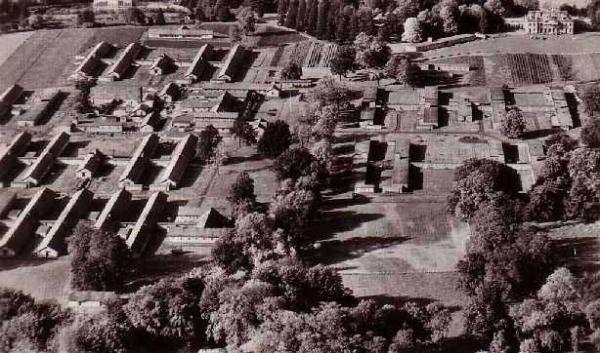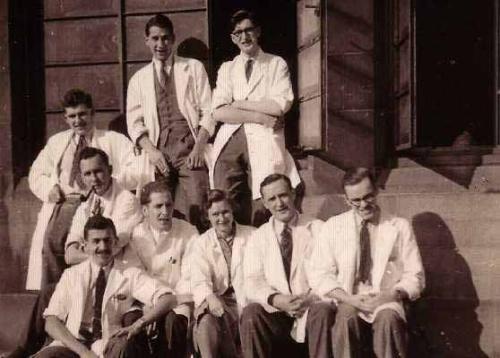The Hospitals
The enormous casualty lists of the First World War were still a vivid memory when plans for building large numbers of temporary hospitals were drawn up. They were built with impressive speed to a standard design, strategically sited at a distance from centres of population, although close to the railway network. New hutted wards were built within existing hospitals, and a number of large houses and hotels were also requisitioned and modified. In total this provided over 20,000 new beds throughout Scotland, a large proportion of which were intended for civilian casualties from the South. Two of the new hospitals were built in Tayside, at Bridge of Earn and Stracathro.
Bridge of Earn Hospital opened in 1940 with space for 1,020 patients. Early admissions came mainly from neighbouring military camps, and the lack of expected air raids led to beds being used by three British General Hospitals, patients with tuberculosis and prisoners of war. The busiest time for the hospital came in 1944, initially from casualties of the V1 and V2 bombing of London, and then the Normandy invasion. "We were full after D-Day" recalled one Sister. "They always came during the night, often treated, but with their first field dressings still in place. From time to time a convoy of German POW arrived, and their wounds were horrific - they had no penicillin". By 1945 there were 1,280 patients, with convoys arriving every weekend. "It was exhausting, but we were a very happy family".

Stracathro Hospital
Stracathro Hospital was built to take 1,000 patients, although the maximum number actually achieved was 999! As with Bridge of Earn, early patients came from nearby troops and local residents, but became it busier later with air raid casualties from the South and after D-Day. Long trains would deliver the wounded at Brechin station. Chief clerk Miss Robertson and her staff would join the train at Bridge of Dun and carry out the documentation, medical staff labelling the patients according to their injuries - Red for Surgery, White for Medical, Green for Orthopaedic. A shuttle service of wartime ambulances then transferred the patients to Stracathro. There were 19 different categories of admission, each of which would receive a different ration allowance, with certain lucky ones also getting a bottle of stout courtesy of Guinness! "It was the Best of Times. It was the Worst of Times" recalled one man who as a young lad handed out sweets and cigarettes to the wounded at the station.

Dr James Riley operating in the bridal suite at Gleneagles Hotel
(Courtesy of the Riley family)
At Gleneagles Hotel, the era of partying, dining and socializing gave way to more serious business as it was transformed into an important military hospital. The hotel's finery was placed in storage and the golf course bunkers filled in to avoid enemy detection. The bridal suite was converted into operating theatres, the lights for these being provided by spotlights from Henry Hall's orchestra! The first convoy of 191 patients from the battle of Narvik in Norway arrived in May 1940 and many more followed from Dunkirk. Famous patients treated included film stars Stewart Granger and David Niven. Later in the War, the Hospital became a Fitness Centre for Scottish miners. The German Foreign Minister von Ribbentrop had stayed at Gleneagles before the war, and apparently had it in mind as a private residence after the Nazis had won the war!

Ashludie Hospital
In Dundee, 200 beds were set aside at the Royal Infirmary (DRI), evacuating existing patients to their homes or other hospitals and restricting admissions to the most acute emergencies. Harris Academy was to be used as a crash hospital should DRI be bombed, while Rockwell School performed the same function for Maryfield Hospital. Maryfield had 85 beds set aside together with gas cleansing facilities. New emergency wards were erected at Ashludie Hospital, while much structural work had to be done to protect every hospital from attack. Most of the costs were met by the government, but DRI had to pay £1,600 for black-out curtains, a considerable sum for what was then a voluntary hospital. As it turned out, Dundee suffered relatively little from air raids, so the number of war-related admissions was small until after D-Day, when many of the wounded were brought to DRI.

Resident medical staff at DRI, 1944 (Courtesy of Dr Harry Goodall)
Sunnyside Hospital near Montrose prepared for war by sand-bagging and gas-proofing its basement windows, digging a large trench opposite the main gate and undergoing rigorous staff training (like making them walk through gas-filled chambers to test their gas masks). The War Office required the hospital to take additional patients from hospitals in Stirling and Aberdeen, forcing its resident population over 1,000 for the only time in its history.

Sunnyside Hospital